Harris C.M., Piersol A.G. Harris Shock and vibration handbook
Подождите немного. Документ загружается.

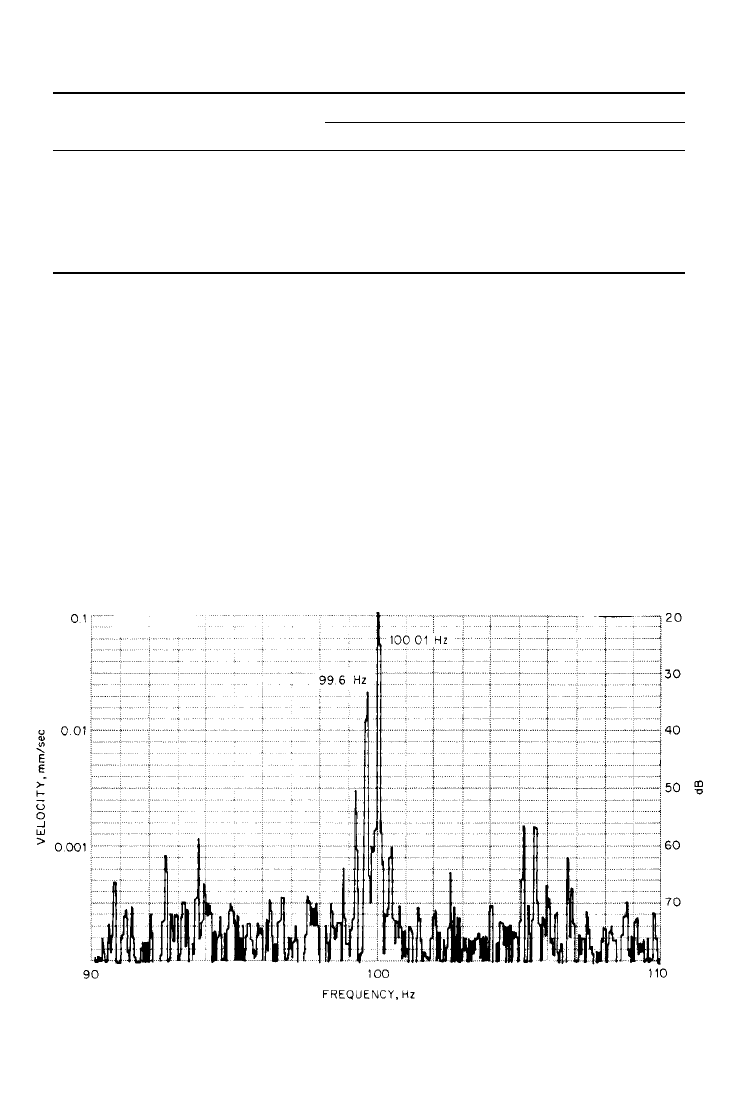
component (i.e., twice the line frequency in Europe), this component can be diag-
nosed as the pole-passing frequency of 100 Hz and not the 2 × rotation speed at
99.6 Hz which could have been an indication of a faulty alignment. This demon-
strates the value of being able to zoom to the frequency region containing the
component of interest. The zoom or extended lines of resolution provides suffi-
cient resolution to separate closely spaced components. It is of no help in analyz-
ing synchronous machines or generators, since the rotation speed and the line
(mains) frequency are identical. In such a case, the machine should be permitted to
coast to a stop. When the power is cut, electrically induced components of vibra-
tion disappear, and the harmonics of the rotation speed gradually decrease in fre-
quency and amplitude.
Vibration forces resulting from an effective variation of the reluctance in the
magnetic circuit as a function of the rate of the stator and rotor slot passing will be
CONDITION MONITORING OF MACHINERY 16.13
TABLE 16.3 “Rotating” and “Stationary” Magnetically Induced Vibrations
in Induction Motors
Type of Symptomatic frequency
Typical cause
problem of vibration Air-gap variations Current variations
Stationary 2 × line frequency Static eccentricity, Stator winding faults
weakness of stator
support
Rotating 1 × rpm with 2 × slip- Dynamic eccentricity, Broken or cracked
frequency sidebands bent rotor, loose rotor rotor bar(s) or shorted
bar(s) rotor laminations
FIGURE 16.5 Spectrum analysis employing zoom frequency analysis around the 100-Hz compo-
nent, measured on the rolling-element bearing of an asynchronous electric motor. Note the simulta-
neous presence of the pole-passing frequency (100 Hz) and the second harmonic of rotation speed
(99.6 Hz). A lesser resolution would not permit a separation.
8434_Harris_16_b.qxd 09/20/2001 12:16 PM Page 16.13

present even in a motor which is in good condition.These vibrations occur at the slot
harmonics given by the following equation:
f
slot
= R
s
f
rot
± kf
line
where f
slot
= slot passing frequency
R
s
= number of rotor slots
f
rot
= rotating speed
k = zero or even number
f
line
= power line frequency
The vibration components at low frequency differentiate between stator problems
and rotor problems.They do not, however, indicate whether the faults originate from
variations in air gaps or current. The components at the slot harmonics, on the other
hand, will behave differently depending on whether the fault originates from an air
gap or current variation as indicated in Table 16.4.
Figure 16.6 shows that by using a zoom around slot harmonics, sidebands can be
observed at twice the slip frequency, thereby permitting the diagnosis of broken
rotor bars. For a four-pole motor, sidebands occur at four times the slip frequency.
As an alternative to using signal analysis of vibration, signal analysis of the motor
current may be used to monitor certain types of problems. It is a more direct meas-
urement for all electrical problems and, with the help of algorithms, makes it possi-
ble, for example, to determine with a certain amount of accuracy the number of
broken rotor bars. Reference 6 mentions that mechanical phenomena such as worn
gears, tooth wear, and steam packing degradation (in motor-operated valves) can be
detected as well. It also mentions the applicability of this technique to dc motors.
HIGHER HARMONICS OF THE ROTATIONAL SPEED
Higher harmonics of the rotational speed typically occur where characteristic fre-
quencies are an integral multiple of the rotational speed of the machine, for example,
in the case of gearboxes, compressors, and turbines, where vibration occurs in multi-
ples of the number of teeth, blades, lobes, etc. An increase in components, such as
tooth-meshing frequencies or blade-passing frequencies, indicates deterioration act-
ing on all teeth or blades, e.g., as uniform wear or increased turbulences, respectively.
“Ghost components” sometimes are observed in vibration spectra obtained from
measurements on gearboxes; these components appear as tooth-meshing frequen-
cies, but at frequencies where no gear in the gearbox has the corresponding number
of teeth. Such components arise from faults on the gear-cutting equipment which
have been transmitted to the new gear. Being geometrical faults, they are not load-
sensitive, nor do they increase with wear; rather, as the gear’s surface wears, they
tend to decrease with time. The frequencies of the components are an integral mul-
tiple of the number of teeth on the index wheel and therefore appear as harmonics
of the speed of rotation of the faulty gear.
SIDEBAND PATTERNS DUE TO MODULATION
Modulations, frequently seen in vibration measurements on gearboxes, are caused
by eccentricities, varying gear-tooth spacing, pitch errors, varying load, etc. Such
modulations manifest themselves as families of sidebands around the gear-tooth-
meshing frequency with a frequency spacing equal to the modulating frequency
16.14 CHAPTER SIXTEEN
8434_Harris_16_b.qxd 09/20/2001 12:16 PM Page 16.14

TABLE 16.4 Troubleshooting Guide of Induction Motor Vibrations
Static eccentricity 2 × line frequency and components Can result from poor internal alignment,
at ω×[nR
s
(1 − s)/p ± k
1
] Radial bearing wear, or from local stator heating
(vibration worsens as motor heats up).
Weakness/looseness Referred to as “loose iron.”
of stator support,
unbalanced phase Difficult to differentiate between this group
resistance or coil sides 2 × line frequency Radial using only vibration analysis, but they will
Shorted stator also be apparent at no load as well as on load.
laminations/turns
Loose stator laminations 2 × line frequency and components Can have high amplitude but not usually destructive.
spaced by 2 × line frequency at Radial The high-frequency components may be similar
around 1 kHz to static eccentricity.
Dynamic eccentricity 1 × rpm with 2 × slip-frequency Can result from rotor bow, rotor runout, or from
sidebands and components at Radial local rotor heating (vibration worsens as motor
ω×[((nR
s
± k
e
) × (1 − s)/p) ± k
1
] heats up).
Broken or cracked rotor bar 1 × rpm with 2 × slip-frequency The slip sidebands may be low level, requir-
Loose rotor bar sidebands and components Radial ing a large dynamic range as well as fre-
Shorted rotor laminations similar to those given above for quency selectivity in measuring instrumen-
Poor end-ring joints dynamic eccentricity with addition tation. Typical spectra show that these components in
of 2 × slip-frequency sidebands the region of the principal vibration slot harmonics
around slot harmonics also have slip-frequency sidebands.
16.15
8434_Harris_16_b.qxd 09/20/2001 12:16 PM Page 16.15
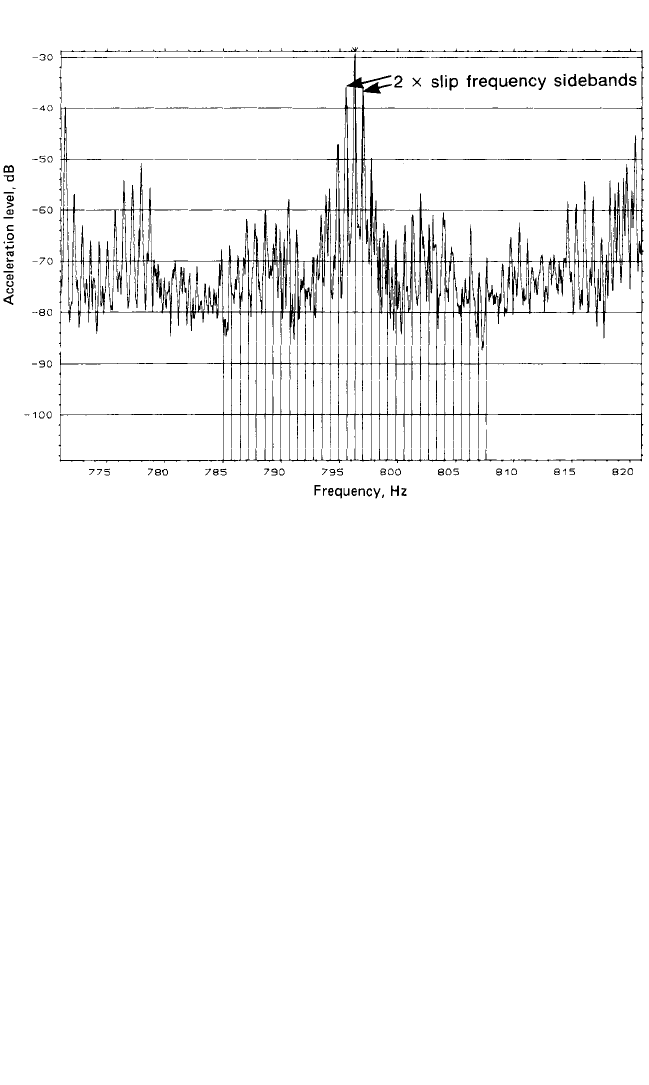
(e.g., the rotation speed of the faulty gear in the case of an eccentric gear). Figure
16.7A shows the distribution of the sidebands for such a condition. Any gear in a
gearbox can be a source of modulation. In order to distinguish all possible sidebands,
the analysis must be carried out with sufficient resolution to detect sidebands with a
spacing equal to even the lowest rotational speed inside the gearbox, and therefore
the zoom feature is indispensable.
Local faults, such as cracked or broken gear teeth, also appear as a family of side-
bands with a spacing equal to the rotation speed of the faulty gear, as this induces a
change in tooth deflection, during meshing, once per revolution. The sidebands
shown in Fig. 16.7B are low in level and cover a broad frequency range. Very often
the influence of the transmission path will modify the shape of the sideband pattern
and does not permit a precise diagnosis.
7
Local faults are best detected in the time
waveform of Fig. 16.7B.
9
Similarly, sidebands at the rotational speed and slip fre-
quency are quite common in patterns for asynchronous machines.
HARMONIC PATTERNS NOT HARMONICALLY RELATED
TO THE ROTATIONAL SPEED
Harmonic patterns which are not harmonically related to the speed of rotation typ-
ically appear where there are local faults in rolling-element bearings.
9,10
A local fault
produces an impulse having a repetition rate equal to the characteristic frequencies
of the bearing: ball-passing frequency for the outer raceway, ball-passing frequency
for the inner raceway, and twice the ball-spin frequency (see Table 16.2). Such faults
appear as a series of harmonics separated by the impact frequency with an ampli-
16.16 CHAPTER SIXTEEN
FIGURE 16.6 Zoom spectrum centered around the second principal vibration slot harmonic,
showing 2 × slip-frequency sidebands on the component at this frequency.
8434_Harris_16_b.qxd 09/20/2001 12:16 PM Page 16.16
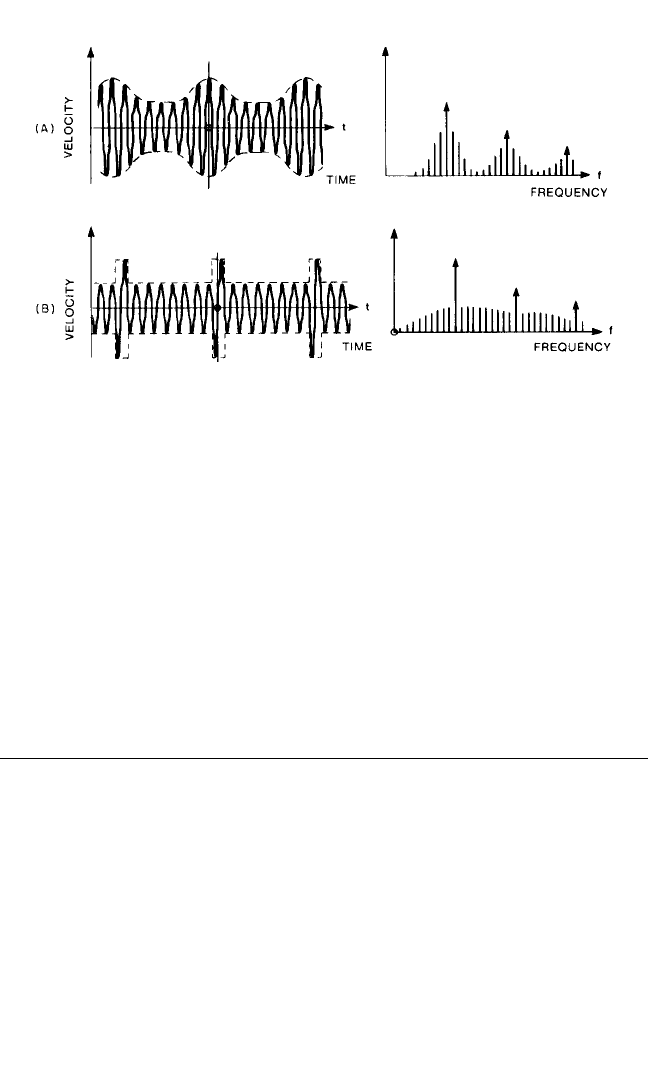
tude proportional to the spectrum of the single impulse. As illustrated in Fig. 16.8,
such an impact tends to excite bearing defect frequencies or excite structural reso-
nances in the frequency range covered, and the harmonic patterns around these
resonances thus are emphasized. This provides two methods of detecting rolling-
element bearing faults: (1) by finding the fundamental of the impact rate in the low-
frequency range; and (2) by finding the harmonic pattern at the impact frequency in
the high-frequency range, where resonances are excited; this may be difficult be-
cause speed fluctuations tend to smear these components.
SPECIAL ANALYSIS TECHNIQUES
Table 16.5 summarizes the applications of the various analysis techniques described
below.
ENVELOPE DETECTION
Envelope detection (envelope detectors are discussed in Chap. 13) is particularly
useful for fault diagnosis in machinery, since it permits elimination of the signal
resulting from background vibration and concentrates the analysis in the frequency
range placing the greatest emphasis on the harmonic pattern of the impact fre-
quency—a resonance of the structure excited by the impulse. This can be done by
either analog or digital means.
11
Figure 16.9 illustrates the analog process. The signal
is first bandpass-filtered around the frequency range where a significant broadband
increase has been detected, as illustrated in Fig. 16.9B and D (usually one or more
resonances between 2 and 20,000 Hz have been excited). The filtered signal (which
CONDITION MONITORING OF MACHINERY 16.17
FIGURE 16.7 Distribution of sideband patterns for distributed and local faults on a
gear. (A) In the case of a distributed fault, sidebands have a high level and are grouped
around the tooth-meshing frequency and harmonics with a spacing equal to the speed of
the faulty gear. The time waveform (lower) shows bursts of energy where the fault passes
through the gear meshing area. (B) In the case of a local fault (such as a cracked or broken
tooth), the sidebands have a low level and expand widely over a large frequency range.
However, the time waveform shows definite evidence of a chipped tooth. (Eshleman.
8
)
8434_Harris_16_b.qxd 09/20/2001 12:16 PM Page 16.17
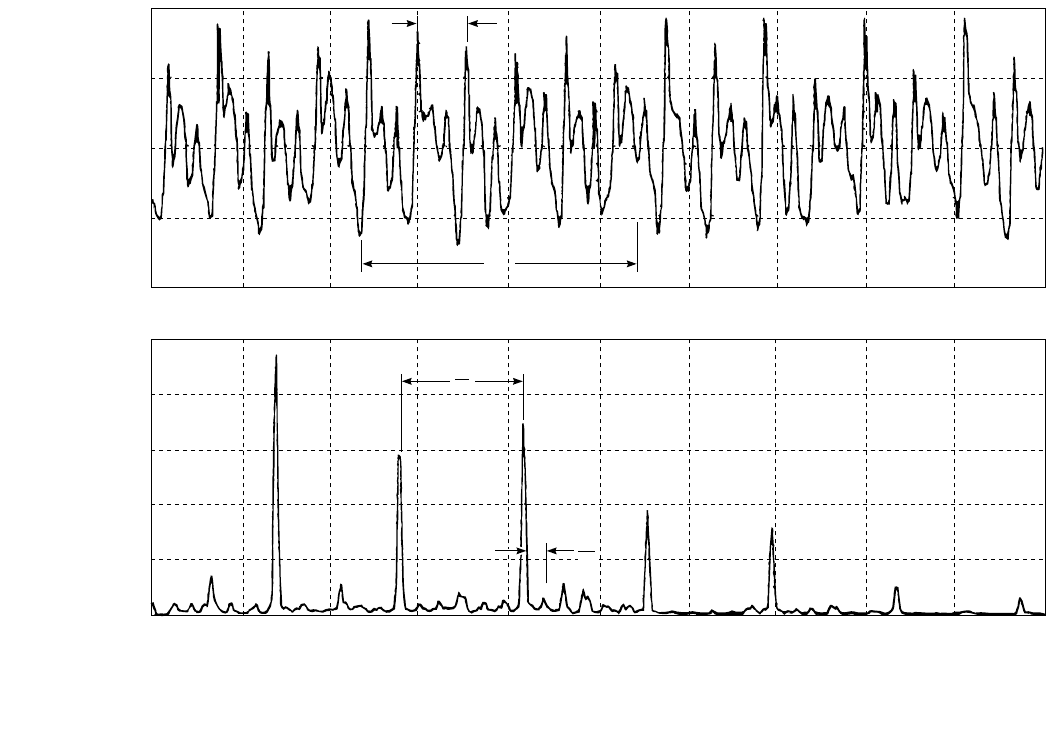
T
1
20
–20
0 320
TIME, MILLISECONDS
VELOCITY, mm/sec
T
(A)
5
0
0 400
FREQUENCY, Hz
VELOCITY, mm/sec
T
1
1
(B)
T
1
FIGURE 16.8 Effect of a local fault in a rolling-element bearing. (A) In the time domain, there is a repeated
impact having a period T. (B) In the frequency domain, the repeated impact results in a line spectrum containing
multiple bearing frequencies with impact rate (1/T
1
) sidebands, where (1/T
1
) is the operating speed of the unit.
(Eshleman.
8
)
16.18
8434_Harris_16_b.qxd 09/20/2001 12:16 PM Page 16.18

CONDITION MONITORING OF MACHINERY 16.19
now contains only the ringing of the selected resonance excited by the repetitive
impacts, Fig. 16.9C) is rectified and analyzed once again in a low-frequency range in
order to determine the repetition frequency of the impacts, as shown in Fig. 16.9E
and F.
The advantages of envelope detection are as follows:
1. The use of bandpass filters eliminates background noise resulting from other
vibration sources (for example, from unbalance or gear vibration). All that
remains is the repetition rate of the impacts exciting the structural resonance,
possibly amplitude-modulated.
2. High-frequency analysis is not required, since only the envelope of the signal is of
importance, not the signal itself, which can extend upward to hundreds of kilohertz.
3. Diagnosis is possible, since the impact frequencies are determined and can be
related to a specific source (ball-passing frequency for the outer raceway, ball-
TABLE 16.5 Typical Applications of the Various Analysis Techniques
Technique Application Fault/machine
Zoom Separation of closely Electrical machines, gearboxes,
spaced components turbines
Improvement of signal-to-
noise ratio, separation of
resonances from pure tones
Phase Operational deflection shapes
Detection of developing cracks
in shafts
Balancing
Time signal Waveform visualization for Rubbing, impacts, clipping,
identification of distortion cracked teeth
Cepstrum Identification and separation Rolling elements bearing,
of families of harmonics bladed machines, gearboxes
Identification and separation
of families of sidebands
Envelope analysis Amplitude demodulation Rolling element bearing,
Observation of a low-frequency electrical machines,
amplitude modulation happening gearboxes
at high frequency
Dynamic crest Calculation of high-pass filtered Faults in low-speed machines
factor signals
Synchronous time Improving signal-to-noise ratio Electrical machines,
averaging Waveform analysis reciprocating machines,
Separating effects of adjacent gearboxes, etc.
machines
Separating effects of different
shafts
Separating electrically and
mechanically induced vibrations
Impact testing Resonance testing Foundations, bearings,
couplings, gears
Scan analysis Analysis of nonstationary signals Fast run-up/coast down
8434_Harris_16_b.qxd 09/20/2001 12:16 PM Page 16.19
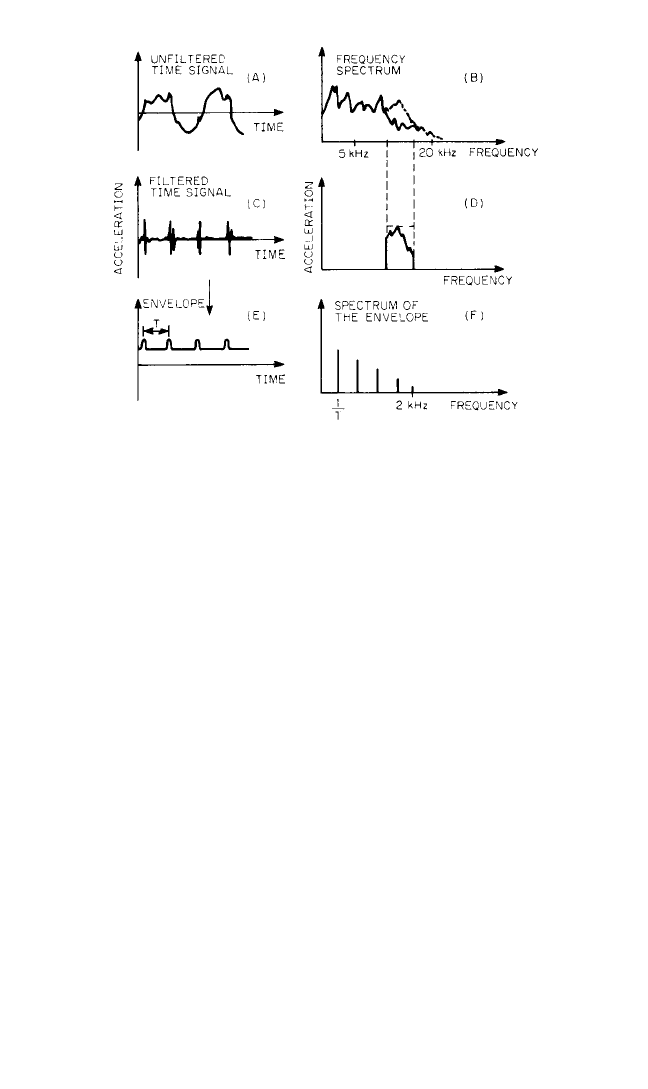
FIGURE 16.9 Principle of analog envelope detection applied to
the analysis of impacts due to rolling-element bearing faults. (A)
Unfiltered time signal. (B) The corresponding spectrum in the fre-
quency domain. (The dotted spectrum represents the reference
spectrum before the fault developed. Note the broadband
increase due to excitation of a resonance by the bearing fault.) (C)
Frequency spectrum after application of a bandpass filter in range
where the change caused by a ball-bearing fault has been
detected. (D) Time signal which corresponds with C; contains ring-
ing of a resonance which is excited periodically. (E) Envelope of
time signal from D. (F) Low-frequency analysis of the envelope
from E, yielding the impact rate due to the fault.
passing frequency for the inner raceway, ball-spin frequency, fundamental train
frequency, or some other source of repetitive impacts, for example, a cracked
gear tooth).
Figure 16.10A and B shows the acceleration spectra from 0 to 25 kHz of a good
bearing and a faulty bearing. Note that the spectrum is noticeably higher on the
good bearing than on the faulty one, which confirms that comparative measure-
ments should not be made between different measurement points or different
machines. Absolute vibration levels do not provide a satisfactory indication of the
condition of a machine; only changes in level are relevant. Any simple method of
bearing fault detection such as shock pulse measurement, spike energy, kurtosis, or
crest factor was difficult to use on this specific machine, because a forced-lubrication
system gave repetitive pulses at a frequency of 5.4 Hz, independent of the rotating
speed, which dominated the whole vibration signal. Figure 16.10C and D shows the
analysis of the envelopes on the good and the faulty bearings obtained after zoom-
ing around 5400 Hz with an 800-Hz frequency span. The only noticeable pattern on
the good bearing comes from the forced lubrication system. In contrast, the result of
the envelope analysis on the faulty bearings shows a complex pattern, and frequency
information is absolutely necessary to confirm whether or not there is a ball-bearing
fault. The following frequencies appear: 5.4 Hz (the repetition rate of the forced
16.20 CHAPTER SIXTEEN
8434_Harris_16_b.qxd 09/20/2001 12:16 PM Page 16.20

lubrication system on the actual bearing, and its harmonics), 6.4 Hz (the repetition
range of the forced lubrication system on adjacent bearings, and its harmonics), and
15.43 Hz (the ball-passing frequency for an outer raceway defect, and its harmonics).
APPLICATION OF CEPSTRUM ANALYSIS
The use of cepstrum analysis (explained in more detail in Chap. 13) is particularly
advantageous for detecting periodicities in the power spectrum (e.g., harmonics and
sideband patterns), since it provides a precise measure of the frequency spacing
between components.
10,11
Figure 16.11 shows the spectrum and the corresponding
cepstrum analysis of a measurement made on an auxiliary gearbox driving a gener-
ator on a gas-turbine-driven oil pump. As a fault on one of the bearing develops, the
first rahmonic appears and then increases at a quefrency equal to the reciprocal of
the spacing in the frequency spectrum which corresponds to an outer raceway defect
in one of the bearings. Another advantage of cepstrum analysis is that one compo-
nent in the cepstrum represents the global “power” content of a whole family of har-
monics or sidebands, and this value is practically independent of extraneous factors
such as machine-load condition, selection of measurement location, and phasing
between amplitude and phase modulation.
Figure 16.12 shows the evolution in terms of time of two different frequency com-
ponents in the spectra of Fig. 16.11. Figure 16.12A represents the evolution of the
harmonic component at 7640 Hz, which shows a clear ascending slope, and also the
evolution of the harmonic component at 5620 Hz, which shows a rather horizontal
slope. Figure 16.12B represents the changes on the first rahmonic in the cepstrum
and shows the effective evolution of the fault corresponding to a steep increase fol-
lowed by stabilization as is typical for a spall in a rolling-element bearing.
CONDITION MONITORING OF MACHINERY 16.21
FIGURE 16.10 (A) Acceleration spectrum of a good bearing in the frequency
range from 0 to 25 kHz. (B) Acceleration spectrum of a faulty bearing in the fre-
quency range from 0 to 25 kHz. (C) Envelope spectrum in 100-Hz range of the sig-
nal in A; the zoom analysis is centered at 5408 Hz and has a frequency span of 800
Hz. (D) Envelope spectrum in 100-Hz range of the signal in B; the zoom analysis
is centered at 5408 Hz and has a frequency span of 800 Hz.
8434_Harris_16_b.qxd 09/20/2001 12:16 PM Page 16.21

FIGURE 16.11 Analyses of vibration of an auxiliary gearbox before and after the devel-
opment of a fault on one of the bearings.
10
(A) Spectrum analysis; (B) the corresponding
cepstrum analysis.
Envelope detection and cepstrum analysis make it possible to determine the fre-
quencies involved precisely and are thus useful for condition monitoring of indus-
trial machines. They permit a reliable diagnosis of defects. Also, cepstrum analysis
appears to be an invaluable condition-related parameter for following fault devel-
opment (e.g., those that develop in rolling-element bearings) that shows up as a fam-
ily of harmonics or sidebands.
The use of post-processing techniques makes it possible to manipulate the cep-
strum, for instance, by removing selected parts of the cepstrum and then transform-
ing the cepstrum back to the frequency and/or time domain. For example, such
manipulations make it possible (1) to evaluate the size of a spall in a rolling element
bearing and (2) to reconstitute the transfer function between the input force and the
vibration response without measuring the input function.
11,12
APPLICATION OF GATED VIBRATION ANALYSIS
ON RECIPROCATING MACHINES
Vibration signals from reciprocating machines (such as diesel engines, reciprocating
compressors, hydraulic pumps, and gas engines) differ from those of rotating
machines in that they are not stationary. Instead, they consist of short impulses
which occur at different points in time for different events (valves opening and clos-
ing, piston slap, combustion, etc.) and are repeated with the same timing for each
new machine cycle. If these signals are averaged over a longer period of time, as is
common practice in the analysis of rotating machines, these individual events would
be averaged out so that changes would go undetected.
In reciprocating machines, different events will excite different resonances of a
structure; the resulting frequencies that are generated provide valuable diagnostic
information. Timing provides equally valuable information because the time when an
event occurs may be related to what is actually happening in the cycle of the engine.
16.22 CHAPTER SIXTEEN
8434_Harris_16_b.qxd 09/20/2001 12:16 PM Page 16.22
